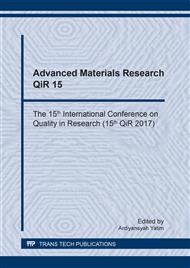p.177
p.186
p.191
p.200
p.209
p.218
p.225
p.234
p.243
Improving the Efficiency of Perovskite Solar Cell through the Addition of Compact Layer under TiO2 Electron Transfer Material
Abstract:
In the fabrication of perovskite solar cells, the perovskite layer is typically deposited onto the TiO2 semiconductor layer. The TiO2 layer serves as an electron transport material (ETM). In order to form the perovskite layer firmly and evenly, a structured mesoporous (MS) TiO2 surface is required. A porous layer could also make the electrons move more quickly through the pores to reach the contact. However, the electron-hole recombination and electron trapping in the dead end pore are still occurred. One of the solutions to overcome this problem is to add a thin compact layer (CL)-TiO2 under MS-TiO2 layer. The CL-TiO2 is expected as to prevent recombination and attract electrons trapped in the MS-TiO2 layer. In this paper, we report the addition of a thin compact layer (CL)-TiO2 under MS-TiO2 layer in the fabrication of perovskite solar cells based on methyl ammonium lead iodide (CH3NH3PbI3). The compact layer TiO2 was grown under mesoporous TiO2 layer by dip-coating in TiCl4 solution. The time of the dip coating was varied to obtain an optimum efficiency improvement. The structure of the device is glass/FTO/CL-TiO2/MS-TiO2/ CH3NH3PbI3/Spiro-OMeTAD/Ag/FTO/glass. It was concluded that the addition of CL-TiO2 can improve the perovskite solar cells power conversion efficiencies. The best efficiency was obtained from the 15 minutes dip-coating, which corresponded to the thinnest CL-TiO2 out of all samples. The electrical characterization performed under irradiation with an intensity of 50 mW/cm2 at 25 °C generated an open circuit voltage of 0.28 V, a short circuit current density of 0.25 mA/cm2 and a power conversion efficiency of 0.60 %.
Info:
Periodical:
Pages:
218-224
Citation:
Online since:
August 2018
Keywords:
Price:
Сopyright:
© 2018 Trans Tech Publications Ltd. All Rights Reserved
Share:
Citation:


